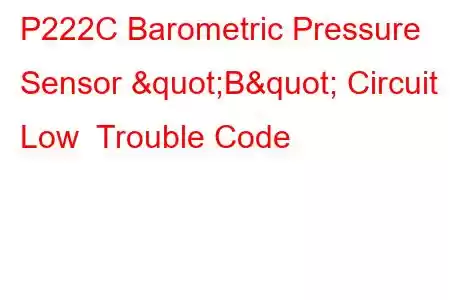P222C Barometric Pressure Sensor B Low
OBD-II Trouble Code Technical Description
Barometric Pressure Sensor B Low
What does that mean?
This is a generic powertrain diagnostic trouble code (DTC) and typically applies to OBD-II vehicles. Vehicles affected may include but is not limited to Chevy, Mazda, Volvo, Acura, Honda, BMW, Isuzu, Mercedes Benz, Cadillac, Hyundai, Saab, Ford, GMC, etc. Although generic, the exact repair steps may vary depending on year, make, model and powertrain configuration.
Most ECMs (Engine Control Modules) rely on a varying amount of measurements to accurately provide the engine an optimal air to fuel ratio. The "optimal" air/fuel ratio is called the "stoichiometric" mixture, 14.7 parts air to one part fuel. Some of the values the ECM monitors to keep the fuel mixture as stoichiometric as possible are, but not limited to: air flow, coolant temperature, engine speed, load demand, atmospheric temperature, etc. Some engine management systems rely more on intake and atmospheric pressures to optimize the mixture.
Not to mention these systems use less sensors to accomplish similar results, as far as fuel management/efficiency is concerned anyway. Usually, BAPs (Barometric Air Pressure) sensors are used when MAP (Manifold Absolute Pressure) sensors are also present. BAPs are used to measure atmospheric pressure. This value is integral to determine fuel mixtures because the ECM needs to compare atmospheric pressures to intake manifold pressures to accurately adjust the fuel mixture according to the operator's driving needs. Altitude is a significant factor to consider when diagnosing BAPs. Depending on your location, your symptoms may actively worsen or improve, especially if you commute frequently through mountainous areas.
When a letter is included within an OBD2 fault code's description (in this case "B"), most times it will be to pinpoint something specific (i.e. different banks, sensors, circuits, connectors, etc.) about the system in which you are working within. In this case, I would say it is to determine which sensor you are working with. A lot of times, there will be multiple barometric sensors to ensure accurate readings. Also, to correlate between sensors to assist fuel management not to mention it helps find faults within the sensors or the circuits. All that said, refer to your service manual for specific details on letter specifications for your particular vehicle.
P222C is set by the ECM when it detects a low electrical value/reading within the Barometric pressure (BAP) "B" sensor or it's circuit(s).
A barometric pressure sensor:
What is the severity of this DTC?
Severity will moderately high here. Reading this, a certain sense of urgency needs to be applied in order to maintain efficient engine operation. Anytime a fault can directly affect very important values such as air/fuel ratios, and is actively present, you should not operate your vehicle, to prevent any engine damage. Having that said, if you've driven the vehicle since the fault has been active, don't worry too much, you are probably fine. Big takeaway, if left unattended, this fault could cause expensive internal engine damage in the future.
What are some of the symptoms of the code?
Symptoms of a P222C trouble code may include:
Lack of engine power and performance (or limited) Engine misfiring Abnormal engine noise(s) Fuel smell Decrease in the fuel economy Decreased throttle responsivenessWhat are some of the common causes of the code?
Causes for this P222C code may include:
Defective or damaged BAP (Barometric Air pressure) sensor Defective or damaged electrical connector Wiring issue (e.g. open, short, corrosion) Electrical short (internal or mechanical) Loose electrical connection Heat damage Mechanical malfunction causing altered BAP readRead: 21


